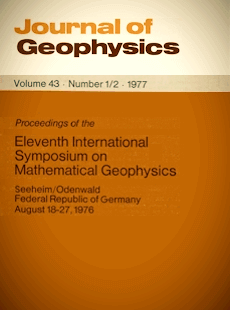Seismic energy transmission in an intensively scattering environment
Article Sidebar

Vols. 1-18 (1924-1944), ISSN 0044-2801
Main Article Content
Abstract
For describing transmission of seismic energy through a medium in which seismic waves are intensively scattered, a statistical approach provides an attractive alternative to the conventional, deterministic approach. The energy transmission in such a medium with a given size distribution of scatterers is generally governed by a diffusion equation with a frequency-dependent diffusivity, rather than wave equations as in the conventional approach. By applying this theory, we can explain many unusual characteristics of lunar seismic signals, including those generated by surface impacts at near and far ranges and by continuous movement of the Lunar Rovers. The size distribution of scatterers can be estimated from the frequency dependence of diffusivity. Predominantly rectilinear particle motions observed indicate that the scattered energy is transmitted as body waves. When intensive scattering is limited to only a part of the transmitting medium, as in the case of far impacts on the Moon, a more general theory combining the two approaches is required. The theory is also useful for interpreting certain characteristics of terrestrial seismic signals because, while frequently ignored, appreciable scattering exists even for terrestrial cases.
 ARK: https://n2t.net/ark:/88439/y052271
ARK: https://n2t.net/ark:/88439/y052271
Permalink: https://geophysicsjournal.com/article/90
Article Details
References
Aki, K., Chouet, B. (1975) Origin of coda waves: source, attenuation, and scattering effects. J. Geophys. Res. 80,3322-3342
Dainty, A.M., Toksoz, M.N., Anderson, K.R., Pines, P.J., Nakamura, Y., Latham, G. (1974) Seismic scattering and shallow structure of the moon in Oceanus Procellarum. The Moon 9, 11-29
Kanasewich, E. R. (1973) Time sequence analysis in geophysics. University of Alberta Press, Edmonton, Canada
Latham, G.V., Ewing, M., Press, F., Sutton, G., Dorman, J., Nakamura, Y., Toksoz, N., Wiggins, R., Derr, J., Duennebier, F. (1970) Passive seismic experiment. Science 167, 455-457
Morse, P.M., Feshback, H. (1953) Method of theoretical physics, Pt. I. McGraw-Hill, New York
Nakamura, Y. (1976) Seismic energy transmission in the lunar surface zone determined from signals generated by movement of lunar rovers. Bull. Seism. Soc. Am. 66, 593-606
Nakamura, Y., Duennebier, F.K., Latham, G.V., Dorman, H.J. (1976) Structure of the lunar mantle. J. Geophys. Res. 81, 4818-4824
Papadakis, E.P. (1968) Ultrasonic attenuation caused by scattering in polycrystalline media. In: Mason, W.P. (Ed.) Physical acoustics, Vol. IV, Pt. B, pp. 269-328. Academic Press, New York
Wesley, J.P. (1965) Diffusion of seismic energy in the near range. J. Geophys. Res. 70, 5099-5106











